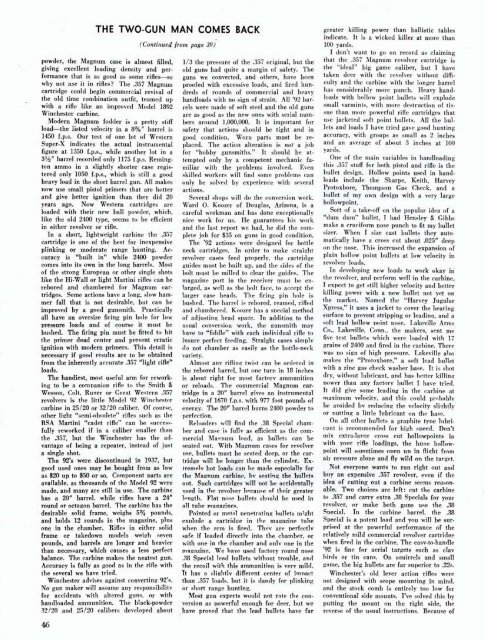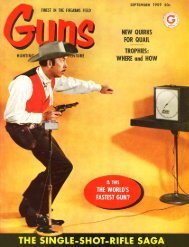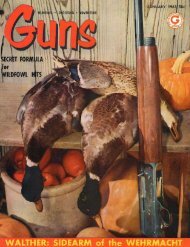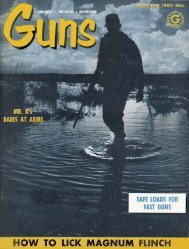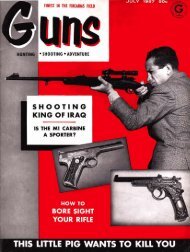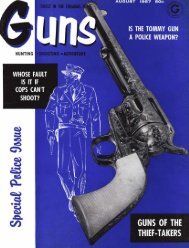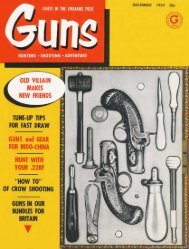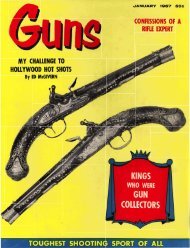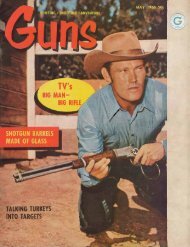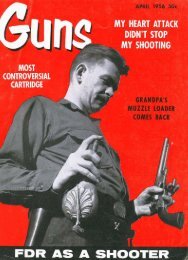You also want an ePaper? Increase the reach of your titles
YUMPU automatically turns print PDFs into web optimized ePapers that Google loves.
.* .<br />
THE TWO~JN'MAN COMES BACK<br />
. ,. - >--.<br />
(Continued from page 39j<br />
greater killing power than ballistic tables<br />
indicate. It is a wicked killer at more than<br />
100 yards.<br />
I don't want to go on record as claiming<br />
-<br />
powder, the Magnum case is almost filled,<br />
giving excellent loading density a d performance<br />
that is as good as some rifles-so<br />
why not use it in rifles? The -3.57 Magnm<br />
cartridge could begin commercial revival of<br />
the old time combination outfit, teamed up<br />
with a rifle like an improved Model 1892<br />
Winchester carbine.<br />
Modern Magnum fodder is a pretty stiff<br />
load-the listed velocity in a 8%'' barrel is<br />
1450 f.p.s. Our test of one lot of Western<br />
Super-X indicates the actual instrumental<br />
figure at 1350 f.p.s., while another lot in a<br />
3%" barrel recorded only 1175 f.p.s. Remington<br />
ammo in a slightly shorter case registered<br />
only 1050 f.p.s., which is still a good<br />
heavy load in the short barrel gun. All makes<br />
now use small pistol primers that are hotter<br />
and give better ignition than they did 20<br />
years ago. Now Western cartridges are<br />
loaded with their new ball powder, which,<br />
like the old 2400 type, seems to he efficient<br />
in either revolver or rifle.<br />
In a short, lightweight carbine the -357<br />
cartridge is one of the best for inexpensive<br />
plinking or moderate range hunting. Accuracy<br />
is "built in" while 2400 powder<br />
comes into its own in the long barrels. Most<br />
of the strong European or other single shots<br />
like the Hi-Wall or light Martini rifles can be<br />
113 the pressure of the -3.57 original, but the<br />
old guns had quite a margin of safety. The<br />
guns we converted, and others, have been<br />
proofed with excessive loads, and fired hundreds<br />
of rounds of commercial and heavy<br />
handloads with no sign of strain. All '92 barrels<br />
were made of soft steel and the old guns<br />
are as good as the new ones with serial numbers<br />
around 1,000,000. It is important for<br />
safety that actions should be tight and in<br />
good condition. Worn parts must be replaced.<br />
The action alteration is not a job<br />
for "hobby gunsmiths.'' It should be attempted<br />
only by a competent mechanic familiar<br />
with the problems involved. Even<br />
skilled workers will find some problems can<br />
only be solved by experience with several<br />
actions.<br />
Several shops will do the conversion work.<br />
Ward 0. Koozer of Douglas, Arizona, is a<br />
careful workman and has done exceptionally<br />
nice work for us. He guarantees his work<br />
and the last report we had, he did the complete<br />
job for $35 on guns in good condition.<br />
The '92 actions were designed for bottle<br />
neck cartridges. In order to make straight<br />
revolver cases feed properly, the cartridge<br />
guides must he built up, and the sides of the<br />
bolt must be milled to clear the guides. The<br />
magazine port in the receiver must be enthat<br />
the .357 Magnum revolver cartridge is<br />
the "ideal" big game caliber, but I have<br />
taken deer with the revolver without difficulty<br />
and the carbine with the longer barrel<br />
has considerably more punch. Heavy handloads<br />
with hollow point bullets will explode<br />
small varmints, with more destruction of tissue<br />
than more powerful rifle cartridges that<br />
use jacketed soft point bullets. All the bullets<br />
and loads I have tried gave good hunting<br />
accuracy, with groups as small as 2 inches<br />
and an average of about 3 inches at 100<br />
yards.<br />
One of the main variables in handloading<br />
this -3.57 stuff for both pistol and rifle is the<br />
bullet design. Hollow points used in handloads<br />
include the Sharpe, Keith, Harvey<br />
Protoxbore, Thompson Gas Check, and a<br />
bullet of my own design with a very large<br />
hollowpoint.<br />
Sort of a take-off on the popular idea of a<br />
"dum dum" bullet, I had Hensley & Gibhs<br />
make a cruciform nose punch to fit my bullet<br />
sizer. When I size cast hullets they automatically<br />
have a cross cut about .025" deep<br />
on the nose. This increased the expansion of<br />
plain hollow point bullets at low velocity in<br />
revolver loads.<br />
In developing new loads to work okay in<br />
the revolver, and ~erform well in the carhine,<br />
rebored and chambered for Magnum car- larged, as well as the bolt face, to accept the<br />
tridges. Some actions have a long, slow hammer<br />
fall that is not desirable, hut can be<br />
improved by a good gunsmith. Practically<br />
larger case heads. The firing pin hole is<br />
bushed. The barrel is rebored, reamed, rifled<br />
and chambered. Koozer has a s~ecial method<br />
all have an oversize firing pin hole for low of adjustinq head space. In addition to the<br />
pressure loads and of course it must be usual conversion work, the gunsmith may<br />
bushed. The firing pin must be fitted to hit have to "fiddle" with each individual rifle to<br />
the primer dead center and prevent erratic<br />
ignition with modem primers. This detail is<br />
insure perfect feeding. Straight cases simply<br />
do not chamber as easily as the bottle-neck<br />
necessary if good results are to be obtained variety.<br />
from the inherently accurate .357 "light rifle" Almost any rifling twist can be ordered in<br />
loads.<br />
the rehored harrel, but one turn in 18 inches<br />
The handiest, most useful arm for rework- is about right for most factorv ammunition<br />
ing to be a comuanion rifle to the Smith & or reloads. The commercial Magnum car-<br />
Wesson, Colt, Ru~er or Great Weqtern .357 tridge in a 20" barrel gives an instrumental<br />
revolvers is the little Model 92 Winchester velocity of 1670 f.p.s. with 977 foot pounds of<br />
b<br />
c;<br />
:-N<br />
5'<br />
carbine in 25/20 or 32/20 caliber. Of course,<br />
other light "semi-obsolete" rifles such as the<br />
BSA Martini "cadet rifle" can be successfully<br />
reworked if in a caliber smaller than<br />
energy. The 20" barrel burns 24QO powder to<br />
perfection.<br />
Reloaders will find the -38 Special chamher<br />
and case is fully as efficient as the comthe<br />
357, but the Winchester has the ad- mercial Mamum load, as bullets can be<br />
vantage of being a repeater, instead of just seated out. With Magnum cases for revolver<br />
a ~ingle shot.<br />
use. bullets must be seated deep. or the car-<br />
The 92's were discontinued in 1937, but tridge will he longer than the cylinder. Exgood<br />
used ones may be bought from as low<br />
as $20 up to $50 or so. component parts are<br />
available. as thousands of the Model 92 were<br />
tremely hot loads can he made especially for<br />
the Maenum carbine, hv seatinq the bullets<br />
out. Such cartridges will not be accidentally<br />
made, and many are still in use. The carhine used in the revolver h~cau~e of their greater<br />
has a 20" barrel. while rifles have a 24" length. Flat no-e bullets should be used in<br />
round or octagon harrel. The carhine has the all tube ma~azineq.<br />
desirable solid frame, weighs 5% pounds, Pointed or met31 uenetratinq bullets might<br />
and holds 12 rounds in the magazine, ~1us exulode a cartrid~e in the magazine tnhe<br />
one in the chamber. Rifles in either solid when the arm is fired. Thev are ~erfectlv<br />
frame or takedown models weigh seven safe if loaded directlv into the chamber. or<br />
pounds, and barrels are longer and heavier with one in the chamber and onlv one in the<br />
than necessary, which causes a less perfect magazine. We have used factory round nose<br />
balance. The carbine makes the neatest gun. 38 Special lead bullets without trouble, and<br />
Accuracy is fully as good as in the rifle with the recoil with this ammunition is verv mild.<br />
the several we have tried.<br />
It has a sliehtly different center of imnact<br />
Winchester advises against converting 92's. than -357 loads. hut it is dandy for plinking<br />
No gun maker will assume any responsibilitv or short range hunting.<br />
for accidents with altered guns. or with Most gun experts would not rate the conhandloaded<br />
ammunition. The black-powder<br />
32/20 and 25/20 calibers developed ahout<br />
version as powerful enough for deer. but we<br />
.have proved that the lead bullets have far<br />
I expect to get still higher velocity and better<br />
killing power with a new bullet not yet on<br />
the market. Named the "Harvey Jugular<br />
Xpress," it uses a jacket to cover the bearing<br />
surface to prevent stripping or leadin?, and a<br />
soft lead hollow mint nose. Lakeville Arms<br />
Co., Lakeville, Conn.. the makers, sent me<br />
five test bullets which were loaded with 17<br />
grains of 2400 and fired in the carbine. There<br />
was no sign of high pressure. Lakeville also<br />
makes the "Protoxbore," a soft lead bullet<br />
with a zinc gas check washer base. It is shot<br />
dry, without lubricant, and has better killing<br />
Dower than any factory bullet I have tried.<br />
It did give some leading in the carbine at<br />
maximum velocity, and this could prnbablv<br />
be avoided hv reducing the velocity sliqhtly<br />
or nutting a little lubricant on the base.<br />
On all other bullets a graphite tme lubri-<br />
cant is recommended for high sueed. Don't<br />
mix extra-larre cross cut hollowpoints in<br />
with yoilr rifle loadings, the huce hollow-<br />
point will sometimes onen UD in flight from<br />
air nressure alone and fly wild on the target.<br />
Not everyone wants to run right out and<br />
buy an expensive .357 revolver, even if the<br />
idea of cutting out a carbine seems reason.<br />
able. Two choices are left: cut the carbine 4<br />
to .357 and carry extra .38 Specials for your<br />
revolver, or make both guns use the -38<br />
Suecial. In the carbine barrel. the .38<br />
Special is a potent load and you will be sur-<br />
prised at the powerful nerformance of the<br />
relatively mild commercial revolver cartridge<br />
when fired in the carhine. The easy-to-handle<br />
'92 is fine for aerial targets such as clav<br />
hirds or tin cans. On sauirrels and small<br />
game, the big bullets are far superior to .22s.<br />
Winchester's old lever action rifles were<br />
not designed with scope mounting in mind,<br />
and the stock comb is entirely too low for<br />
conventional side mounts. I've solved this by<br />
putting the mount on the right side, the<br />
reverse of the usual instructions. Because of


